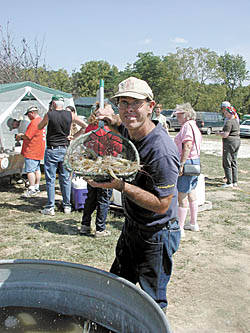
Last year Paul Smith turned 5 lbs. of baby shrimp into 465 lbs. of freshwater prawns. At harvest, he had a party and made a little money. This year he plans to raise more shrimp and also sell stock to other farmers to start their own ponds. The Missouri farmer calls his growing aquaculture business the Show-Me Shrimp Farm.
"I'm the Johnny Appleseed of shrimp farming in central Missouri," Smith says. Five years ago, a television news segment about an Illinois shrimp farmer intrigued the tool-and-dye worker enough to take a 5 1/2-hour trip to go see the operation himself. He'd always had an interest in aquaculture, but raising bluegills and trout didn't grab his attention like shrimp did. The shrimp are a fresh water variety, native to Malaysia.
Despite naysayers in Missouri's Department of Agriculture, Smith researched and found valuable information at Kentucky State University. With the encouragement of a $3,000 sustainable ag grant and a personal investment of 401K money, he drilled a well, had a pond dug and added a lean-to greenhouse to the side of a barn that once housed his parents' dairy cows. The first year he drove 8 1/2 hours to Texas to buy 10,000 21-day-old shrimp, about 1/4 in. long. He successfully raised them to 3/4 in. and put them in his pond. They grew and all was going well, but Smith didn't fully realize the impact of cold weather.
He didn't harvest the shrimp soon enough and he lost them all, but he learned valuable lessons that have improved his operation each year. The process goes something like this.
It's harvest time and party time all rolled into one.
Last year 400 people attended Smith's 3rd annual Shrimp Festival. Helpers netted the prawn shrimp out of the catch basin into ice cold water, where they die in 15 minutes. People lined up and bought 400 pounds of shrimp. (about 15 prawns/lb.). Smith said they could be bigger, but he doesn't want to risk an early cold snap. He figures his season is about 120 days.
Since Smith isn't licensed to process food, consumers clean the prawns themselves, after he demonstrates how to pop off the heads and prepare them for cooking. For the festival, Smith contracted with a Cajun cook to boil the shrimp and offer a lunch of corn and potatoes.
"The shrimp are delicious. They taste more like lobster," Smith says of his organically raised prawns. "I want this to be an event people look forward to coming," he adds. For next year's festival, he's lined up a musician from Texas and an accordion player from Oregon, several food vendors, wine tasting, horseshoes, volleyball and lots of kids' games. Smith doesn't charge an entry fee, and he offers free camping on his 50-acre farm.
Holding a festival is a lot of fun and takes care of marketing, Smith says.
For 2007, he's going to raise more than 15,000 shrimp. Plus, he's building a pool inside the gambrel-roof barn for a nursery to raise shrimp from 21 to 60 days and sell them to pond owners who want to get into the business.
Shrimp farming is taking off. There are at least 13 operations in Missouri.
People considering it should understand that the setup is expensive. There are also risks -- cold weather, as well as some losses to predators such as blue herons. Smith's setup includes aeration and automatic timers for feeding.
As he plans for his fourth harvest, Smith remains enthusiastic about raising shrimp and his role as an aquatic Johnny Appleseed.
